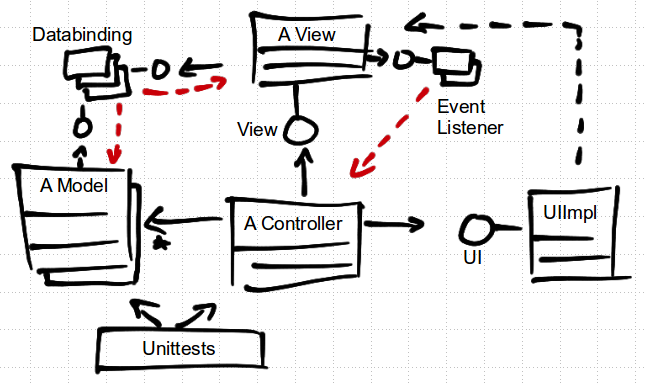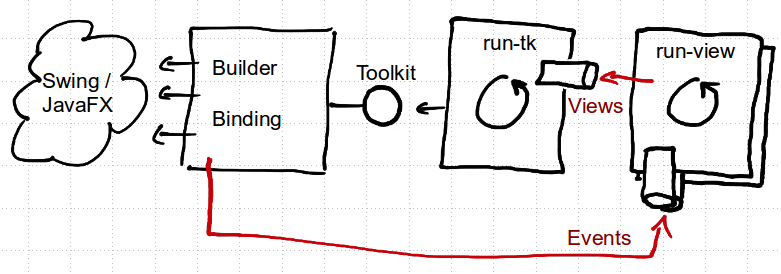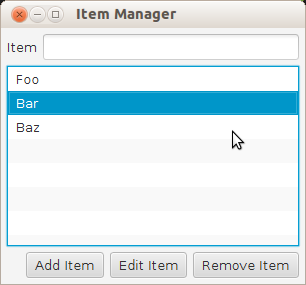Applying Clojure core.async to JavaFX
01.05.2014
Permalink
If you ever created a non-trivial enterprise rich client
application with many UI forms you will have noticed that it is
quite a challenge. Given the conditions that apply this is no
surprise:
- UI toolkits like Swing, JavaFX or others are packed with mutable
state.
- The layout and configuration of widgets is usually very verbose or
requires the time-consuming use of point-and-click designer tools.
- Every piece of presentation logic is triggered on the basis of
callbacks.
- Actions that change UI must do so by causing side-effects.
- To make a UI responsive we have to deal with multiple threads.
- Testing presentation logic is often very hard if it's mixed up with
code that accesses UI. This forces us to employ UI robots and to
maintain brittle test scripts.
- A usable UI is often the result of numerous iterations until user
needs are sufficiently satisfied. Thus changes in UI code
happen often.
As a result rich client code often exhibits overwhelming
complexity and quickly becomes unmaintainable. Considering
the importance a user interface has for product acceptance and
the amount of code necessary to produce a sufficient user
experience, this is an unsatisfying situation.
In the past, I worked on several rich clients in OO languages
like C++ and Java. The best ideas I was able to find in OO land
beyond the very basic - but still somehow applicable -
separation of responsibilities into Model, View and Controller
(MVC) were
Model-View-Presenter
and
Presentation Model.
Both patterns essentially address the problem of how to make
presentation logic unit-testable without using GUI robots and
brittle test scripts.
An improvement, but still not satisfying
In a customer project two years ago, I used separate classes for
data - the Model - and actions - the Controller. I built a
textual UI form DSL
and a corresponding code generator that produced
View classes, and added a full-blown data binding between Model
and View. In addition I invented a UI interface to give the
Controller a mockable API for UI operations, e.g. creating a new
UI form or showing a message box.
Here's an overview of this design:

This already allowed the team to produce unit-testable client
code without having to deal with many of the tricky details of
GUI development, but the client still heavily used callbacks in
disguise of "action methods", and these methods did their work
through in-place mutation in Model and Controller
instances. Even worse, in order to execute long-running actions,
developers still had to create two additional levels of
callbacks, one for the long-running operation and the other to
merge the results back into the view. This was the forecourt to
callback hell, and it is
still the default way in JavaFX and Swing to keep the
application responsive to user input. So the code expressing the
presentation logic was still messy, nonetheless it was the best
I was able to come up with by that time.
And now for something completely different
Through learning Clojure I came across ideas like
Functional Reactive Programming
(FRP) and
Communicating Sequential Processes
(CSP). These approaches allow us to treat some of these problems
in a different way.
In the last few months, I tried to apply FRP in my experimental
library
visuals,
which is based on a home-grown
implementation of
Signals (a.k.a Behaviours), Eventsources (a.k.a Eventstreams)
and corresponding operations, which I re-implemented in fall 2014.
You can find some links to papers about FRP on the
GitHub page of reactnet.
Coincidentally, I started my work on reactor around
the same time that James Reeves started to work on
reagi, and
shortly after that Rich Hickey published
core.async.
I applied FRP to enterprise-style UI forms in a very direct
manner: Each visual component of a UI toolkit (e.g. a window,
textfield, button, table, ...) provides mutable properties that
allow to register listeners. This concept is strikingly similar
to what FRP "behaviours" do in practice. So I adapted these
properties of visual components to conform to reactor's Signal
protocol (which represents a "behaviour"). Button presses or
input-focus changes can likewise be seen as Eventsources, so
consequently I registered numerous listeners that feed into
individual Eventsource instances. This finally enabled me to
represent all mutable data and events in the unified terms of FRP.
Although I experienced some relief from the resulting
uniformity, I eventually got stuck, because my FRP implementation
didn't seem to offer a natural way to express the interaction
between UI forms. Similarly, I didn't see a way to handle
long-running actions without resorting to some kind of callback
mechanism.
Perhaps my FRP implementation was simply missing the
important Inversion of Control feature core.async provides. To
summarize: I consider this experiment as a learning exercise,
but not as a result to base future work on.
Update 31.10.2014: As it turned out, reactor was missing the
flatmap combinator. I discovered this very recently
while approaching GUI form interaction with my new reactor
re-implementation. So, it is possible to solve this problem by
using an FRP library that offers to dynamically create and
connect new eventsources, which is essentially what a
flatmap does with a passed-in function.
A Process-and-Channel oriented approach
Inspired by David Nolens
article
about CSP in ClojureScript and my recent learnings about how UI is managed in
55 years old
IBM RPG
I switched with my current
async-ui prototype
over to CSP and
core.async.
Here's a picture giving a rough overview of the design:

The rich client consists of
processes and the state of
the
toolkit. The term "toolkit" refers for example to
JavaFX or Swing. A process is a core.async
go block.
There are two predominant types of processes:
- One is the single toolkit oriented process, started by
invoking the
run-tk function. Its purpose is
to keep the toolkit state in sync with the data that
represents views. It reads view data from a central channel
and causes effects to the UI toolkit, e.g. creating a visual
component tree or updating data within such a tree.
- The other is a view oriented process, started by
invoking the
run-view function. Its purpose is to
update the view data according to events it reads from the
events channel each view has.
A
view is a map that contains a specification of the
visual component tree, the domain data, a mapping between both,
validation rules and validation results. This data represents
the state of a UI form. In addition each view has its own
events channel and references the root of a toolkits visual
component tree (a JavaFX
Stage or a Swing
JFrame instance). For each view, one process is
started, which processes events for that view. "Event
processing" means that the data contained in the event is merged
into the view state, validation is applied, an individual
handler is invoked and the resulting view is passed via the
central channel to the toolkit oriented process.
An
event is a map created by toolkit specific event
listeners that write them into the events channel of the
corresponding view.
The concrete UI toolkit like JavaFX or Swing is kept behind the
toolkit protocol. It is mainly implemented by a
Builder and a Binding. The
Builder takes the specification of a
form and translates it to JavaFX or Swing API calls in order to
create an actual visual component tree. The
Binding registers
listeners that put an event onto the views own events channel
and creates setters that update the visual components properties
with the data contained in the view.
An example
The
example
I have prepared so far shows a little master-detail scenario.
Here's how the master form looks like when run with JavaFX:

To start the view process the following expression suffices:
(v/run-view #'item-manager-view
#'item-manager-handler
{:item ""
:items ["Foo" "Bar" "Baz"]})
You can see that two function-vars are referenced, one points to
the factory function that creates the initial data that
represents the view. The other one points to the event handler
function.
The visual component tree and the mapping is expressed by the factory
function:
(defn item-manager-view
[data]
(let [spec
(window "Item Manager"
:content
(panel "Content" :lygeneral "wrap 2, fill"
:lycolumns "[|100,grow]"
:lyrows "[|200,grow|]"
:components
[(label "Item") (textfield "item" :lyhint "growx")
(listbox "items" :lyhint "span, grow")
(panel "Actions" :lygeneral "ins 0" :lyhint "span, right"
:components
[(button "Add Item")
(button "Edit Item")
(button "Remove Item")])]))]
(-> (v/make-view "item-manager" spec)
(assoc :mapping (v/make-mapping :item ["item" :text]
:items ["items" :items]
:selection ["items" :selection])
:data data))))
The event handler is another Clojure function, and by means of the
go block an asynchronous process:
(defn item-manager-handler
[view event]
(go (assoc view
:data
(let [data (:data view)]
(case ((juxt :source :type) event)
["Add Item" :action]
(-> data
(update-in [:items] conj (:item data))
(assoc :item ""))
["Edit Item" :action]
(let [index (or (first (:selection data)) -1)]
(if (not= index -1)
(let [items (:items data)
editor-view (<! (v/run-view #'item-editor-view
#'item-editor-handler
{:text (nth items index)}))]
(if-not (:cancelled editor-view)
(assoc data
:items (replace-at items index [(-> editor-view :data :text)]))
data))
data))
["Remove Item" :action]
(assoc data
:items (let [items (:items data)
index (or (first (:selection data)) -1)]
(if (not= index -1)
(replace-at items index [])
items)))
data)))))
The
go block is needed here because the master may
start another asynchronous view process for displaying and
handling the detail view. Please note that the communication
between master and detail is almost like an ordinary function
invocation. The master view process is paused until the detail
process finishes.
Benefits
As it turns out, the channels establish a strict separation
between the toolkit oriented process, which handles
synchronization of view state with the visual component tree,
and the view oriented process, which applies events to the view
state and pushes updates into the central toolkit channel. While
the toolkit oriented process must deal with all the dirty
details of the JavaFX or Swing API, and has to keep mutable
state in sync with the view state, the view oriented process
solely deals with data transformation based on events, which
themselves are simple maps. This is an important property,
because it allows the frontend developer to stick to Clojure
core functions to get his work done.
Unit testing presentation logic becomes a no-brainer, since we
can feed events into the views channel and must only assert that
the view state changes as expected.
The interaction between different views uses ad-hoc channels
as returned by a
go expression. By immediately
starting a blocking read, view processes can wait for each other
without blocking the UI event thread.
The channel infrastructure can also be used for dealing with
long-running actions like calling remote services, which can
easily go either into their own future, or use a non-blocking
callback based API. Upon availability of the results the process
feeds these into the events channel of a view, which handles
them like any other event.
Conclusion
While I still think that FRP allows for very elegant solutions
in the area of graphics animation or gaming, its core concepts
"behaviour" and "eventsource" seem not crucial for solving
the wide-spread problems in enterprise GUIs. But I'd like to be
proven wrong on this point.
Update 31.10.2014: After I found out how form interaction can be
expressed by means of FRP combinators, I consider it as one
viable option to create typical enterprise "forms-over-data"
GUIs. However, it took quite some time to grok this. For me, a
helpful key insight was that eventsources are the way how
asynchronous processes convey their results.
The idea of asynchronous processes is better visible in CSP
because it materializes as
go blocks in the code,
thus after I dissected the whole problem into separated
processes which are only coupled loosely through channels that
carry dumb data, things became much easier.
My doubt about whether it makes sense to create a full-blown
Clojure library for JavaFX programming has grown. While I'm
convinced that the ideas and the design I used (like separated
processes connected via channels, view representation by pure
data, an explicit builder and a binding) are a good foundation,
I'm afraid that project specific requirements between different
applications vary in numerous details. A library that provides
the level of comfort I consider as necessary inevitably becomes
a batteries-included framework with lots of assumptions and
implicit behaviour. My experience with those frameworks in
Java-land tells me that such a "claim of omnipotence" almost
always leads to pain and horrendous work-arounds. I still have to
make up my mind if there is any piece in this picture that can
be extracted to form a useful library.
Meanwhile, please feel free to exploit these ideas and the code I
pushed to my
GitHub repo.


